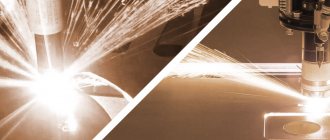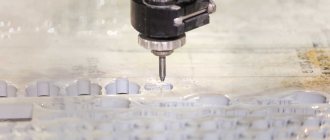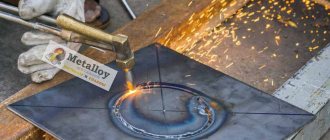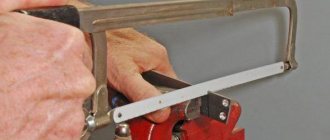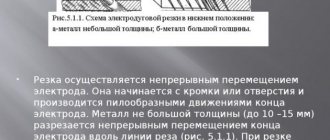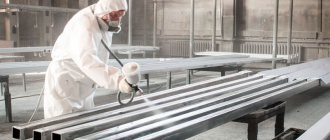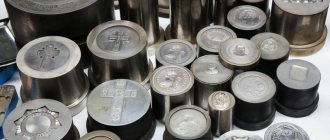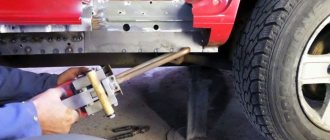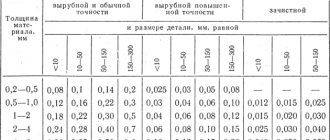Consumables
To create a cutting surface, only two components are required:
- water;
- abrasive.
The latter is consumed very quickly - about 350 grams per minute. It consists exclusively of natural garnet sand, no more than 600 microns in size.
There is an opinion that garnet sand can be replaced with any other. Unfortunately, this is a blatant lie, because such a substitution will not only make a low-quality cut, but also quite quickly lead to wear and tear of important parts of the mechanism.
Water and abrasive supply process
The water, in turn, must be purified. The more impurities it contains, the lower the quality of cutting metal or any other material.
Of course, air and electricity are also important, but it is more important to monitor water and abrasive
The essence of technology
Waterjet cutting of metal is not an innovative technology; it began to be used back in the 1960s. The American aircraft manufacturing company was the first to use machines to perform such cutting. It was the management of this company that made an official statement about this method, describing its advantages and recommending its use for cutting metal and other materials with high hardness. From that moment on, abrasive cutting of metal using water began to be actively used by enterprises and gained increasing popularity.
The essence of this technology is that water, which contains abrasive substances, is supplied to the cutting zone under high pressure. Any waterjet cutting installation works according to the following scheme.
- Water and abrasive material, which is mainly used as fine sand, are supplied from a special container to the mixer of the apparatus.
- After mixing, the water and abrasive enter the nozzle of the installation.
- A thin jet of waterjet mixture is formed in the nozzle, which is supplied under high pressure to the cutting zone.
Operating principle of hydrojet cutting
Technology implemented according to a similar scheme allows not only to perform cutting quickly and with high quality, but also to significantly save on consumables, the most expensive of which is ordinary sand. It should be noted that in terms of speed, abrasive cutting using water is comparable to plasma technology, and in terms of the quality of the resulting cut, it is comparable to laser technology.
Popular manufacturers of waterjet machines and their prices
Another disadvantage of waterjet cutting machines is their high price, which is not yet accessible to the general consumer.
The most popular manufacturing companies present on the Russian market are:
- OMAX (USA);
- Jet Edge (USA);
- PTV (Czech Republic);
- Resato (Holland);
- Bystronic (Switzerland);
- Caretta Technology (Italy);
- ALICO (Finland).
The average market price of equipment of these brands is about 250 thousand euros.
In addition, there are several other companies that produce components and consumables for waterjet machines, among them:
- AccuStream (USA);
- UHDE (Germany);
- Thueringer (Germany);
- BHDT (Austria).
The range of these companies also includes systems for cutting heads, abrasive supply tubes, heavy-duty pumps and other components for systems.
Naturally, the high price is partly due to the fact that the products are imported. As for the domestic manufacturer, which assembles and sells waterjet cutting machines, it is worth mentioning. The price of the products will be slightly lower than foreign analogues, but parts and components for assembling machines are used both foreign and Russian.
Waterjet machine - operating principle
The high-pressure pump, using a booster, pumps up pressure from 300 to 600 atmospheres. At the same time, all vibrations created by the pump are damped in a large-capacity pressure accumulator, which guarantees a pulsation-free stream of water. After this, water to generate a jet can be supplied to any arbitrary point through flexible high-pressure pipes.
Water passing through a hole in the head with a diameter of a quarter of a millimeter (the pressure increases even more) enters the mixing chamber. There it combines with abrasive (fine sand) and enters the nozzle that forms the jet. Depending on the thickness and material of the part, it can have a diameter of 0.6-1.2 mm. In the cutting head, the energy of water pressure is converted into the kinetic energy of the water jet. Water passing through a nozzle, just tenths of a millimeter in size, made of super-hard materials, is accelerated to form a thin, focused jet that serves as a cutting tool.
Soft materials such as rubber and plastic are cut with a clean stream of water. By adding sand to the jet to enhance cutting capabilities, it is possible to process materials of any hardness, such as metals, stone, glass, and composites. For hard materials, rough drilling is performed first. For some materials, preliminary centering is not necessary, since when centering the material, the first drop of water is mixed with the abrasive. Today, waterjet cutting allows you to easily cut materials up to 150 mm thick.
This method allows you to cut materials without releasing thermal energy, since it is immediately absorbed by water. In addition, complex and heavy devices for fixing the workpiece are not required. A jet of water does not have such a strong impact on the workpiece as mechanical tools (cutter, milling cutter or saw).
Equipment in industry
Modern machines for professional use allow processing stainless steel up to 20 centimeters thick. In this case, the strength indicators and group of metals are not important. The small jet diameter (1 mm) allows cutting to a very high tolerance. If an industrial machine is used, then it becomes possible to process stone and other hard rocks, such as marble, etc.
Currently, this is one of the most effective and popular glass cutting methods. GAR works with both thin crystal and bulletproof glass with micron accuracy. Today, GAR machines are used for the production of gaskets and the processing of foam materials such as rubber and plastic. But to achieve optimal results, it is necessary to use modern electronic systems and various scanners.
Special equipment for CNC machines
machine with movable console
Height and anti-collision sensors monitor the distance between the material surface and the nozzle. They prevent the head from moving under water pressure and from colliding with vertical surfaces during operation. Before starting work, the controller determines the thickness of the material and the required working depth. Periodically during operation, the sensor makes adjustments to its operation depending on the operations already performed.
The laser pointer makes it possible to accurately “aim” when placing a part on the worktop, and quickly positions the nozzle. The function is applied on the small and large coordinate tables. The pointer is reliably protected from water by a strong waterproof case.
The substrate is used to process small parts and improve contact between the water-sand jet and the material. The substrates have a special structure that easily allows water to pass through and reliably holds the part.
A set of clamps is provided with each machine. With its help, parts of various sizes and shapes are firmly fixed on the tabletop.
A pump cooling system is essential for efficient operation. It can be closed or flow-through. Closed is more economical.
The abrasive feed dispenser controls the amount of abrasive for working on material of different thicknesses
Eliminates interruptions in the supply of abrasive, which is very important when cutting valuable materials, the treatment of which with clean water can damage them
The water purification system prevents the appearance of mineral deposits on valves, hinges and other elements of the CNC machine. The water is cleared of calcium and iron. The permissible amount of iron in 1 liter of water is no more than 10 milligrams. The cleaning system increases the productivity and life of the CNC machine.
Videos demonstrate waterjet cutting in three-dimensional and two-dimensional spaces:
CNC waterjet machines
The possibility of using programmable CNC machines for waterjet cutting of stainless steel, aluminum, copper, and other types of ferrous and non-ferrous metals of varying strengths has made it possible to significantly increase and expand the scope of application of the equipment.
Thanks to CNC machines, it is possible to produce precise parts with minimal deviation from specified dimensions, which is almost impossible to achieve with traditional cutting methods. The operating principle of CNC waterjet equipment is as follows:
- Software for waterjet cutting on CNC machines is installed. Each material has its own software that automatically selects the composition of the cutting mixture, jet pressure and other necessary parameters. The program allows you to provide figured cutting of the material.
- Additional processing - usually after processing the material using a machine, it is not required. But if the composition of the cutting jet is incorrectly selected, slight surface roughness may be observed after HAR. Cut roughness is virtually eliminated when using machines with software. The CNC machine analyzes the quality of the cut and automatically adjusts the selected mode.
- In addition to cutting the material, a CNC waterjet metal cutting machine allows you to drill holes of the required diameter. Some CNC waterjet machines contain additional equipment to perform certain operations.
- After processing the workpiece, a completely finished part is obtained, which does not require additional grinding or modification of the cutting area.
Machines for waterjet cutting of small parts with numerical control may differ in functionality and main purpose
Before purchasing a CNC machine for cutting small-format parts, you need to pay attention to the scope of application and recommendations related to operation
Advantages and disadvantages of cutting using abrasive and water
You can even evaluate the efficiency, productivity and accuracy of waterjet cutting from a video of the process. Meanwhile, there are not only visually assessed advantages of this technology, which include:
- exclusion of heating of the workpiece (hence the impossibility of its deformation and, accordingly, high cutting accuracy);
- wide functionality of the equipment, with which you can solve problems of even the highest complexity;
- no need for additional work to refine the resulting products;
- the versatility that any waterjet cutting machine has (it can be used to cut rubber, plastic, stone or metal, and drill holes in various materials);
- high speed, accuracy and cost-effectiveness of the process;
- exceptional safety of the process, including its explosion and fire safety;
- the ability to cut parts of large thickness, including tubular sections.
Hydrojet cutting of marble
No matter how effective and impressive the waterjet cutting process is (see video at the end of the article), this technology also has disadvantages. In particular, these include the following.
- When cutting, a taper is formed on the edge of the cut piece. This disadvantage is especially noticeable when cutting parts of large thickness. To prevent the appearance of this defect, it is necessary to use special automated devices that correct the nozzle angle during processing.
- Waterjet machines process both thick-walled and thin-walled parts at the same speed, which somewhat reduces the profitability of using this technology. To increase profitability, thin parts are cut several pieces at a time, putting them in a pack.
The use of waterjet cutting is especially advisable in situations where it is necessary to cut complex parts with particularly high precision, while spending a minimum amount of time.
Auxiliary elements
High pressure pump with water filter. As already mentioned, the inlet pressure is thousands of atmospheres. Such parameters require a continuous supply of liquid in appropriate volumes.
To minimize costs, water and abrasive garnet sand are reused. Passing through the filter system, the liquid is cleaned of dirt and oil formations. Often machines are equipped with a separate water tank.
Garnet sand for hydrojet cutting - video
The abrasive is dried and separated from pieces of material, especially if it is plastic or metal. Magnetic separators are used to separate metal. Just like water, sand is stored in separate containers.
Control
Control can be carried out through the interface of the machine itself, or by loading prepared task files into the system in the form of drawings and technological parameters prepared in the format of any graphic editor compatible with the machine software (CAD. COREL-DRAW or similar).
The operator, using the interface service, can set the coordinates of the beginning and end of the movement, adjust the cutting speed and direction.
The task is transferred to the automated control system to perform operations.
After this, you need to install the cutting head at the starting point and start the machine. The machine software converts the task file data into control commands for the pump, abrasive dispenser and head drive motors.
The ACS feedback reads sensor readings, adjusts the water supply and the speed of the head, monitors the completion of the task, and ensures planned or emergency shutdown of the machine.
In addition, the operator has the ability to stop the device at any time, turn off the pump and relieve pressure in the system.
Advantages, disadvantages and comparative characteristics
Using a waterjet or water jet, you can cut almost any material. In this case, neither mechanical deformation of the workpiece occurs (since the force of the jet is only 1–100 N), nor its thermal deformation, since the temperature in the cutting zone is about 60–90°C. Thus, compared to heat treatment technologies (oxygen, plasma, laser, etc.), waterjet cutting has the following distinctive advantages:
- higher quality of cut due to minimal thermal effect on the workpiece (no melting, melting or burning of edges);
- the ability to cut heat-sensitive materials (a number of fire and explosive materials, laminated, composite, etc.);
- environmentally friendly process, complete absence of harmful gas emissions;
- explosion and fire safety of the process.
The water jet is capable of cutting materials up to 300 mm thick and more. Cutting can be performed along a complex contour with high precision (up to 0.025–0.1 mm), including for processing volumetric products. You can use it to make bevels. It is effective on aluminum alloys, copper and brass, due to their high thermal conductivity, thermal cutting methods require more powerful heating sources. Additionally, these metals are more difficult to cut with lasers due to their low ability to absorb laser light.
The disadvantages of water-abrasive cutting include:
- significantly lower cutting speed of thin steel compared to plasma and laser cutting;
- high cost of equipment and high operating costs (typical for laser cutting) due to the consumption of abrasive, electricity, water, replacement of mixing tubes, water nozzles and seals that can withstand high pressure, as well as waste disposal costs;
- increased noise due to the flow of a jet at supersonic speed (typical for plasma cutting).
Waterjet cutting price
There are at least five components that determine the high price of equipment:
- high pressure pump and piping system;
- high-precision head movement control drives;
- intelligent control system;
- a nozzle made of precious stones (albeit of artificial origin);
- mixing tube made of high hardness composite.
And if we take into account that the last two components are consumables and add the high price of the abrasive, then the cost of waterjet cutting will be the most expensive among all types. But the advantages of this method and the quality of processing of the part are worth it.
Technological parameters
The main technological parameters of the waterjet cutting process are:
- cutting speed;
- type, properties and thickness of the cut product;
- internal diameters of the water nozzle and mixing tube;
- type, size, flow rate and concentration of abrasive particles in the cutting mixture;
- pressure.
Cutting speed (the speed at which the cutting head moves along the surface of the workpiece) significantly affects the quality of the cut. At high speeds, the water-abrasive jet deviates (drifts) from straightness, and the jet weakens noticeably as the material is cut. As a result, the taper of the cut and its roughness increase.
Read also: Chainsaws rating price quality up to 6000 rubles
Drawing. Typical cut shape depending on cutting conditions
Drawing. Jet drift when cutting at a speed higher than optimal
Separation cutting can be performed at 80-100% of maximum speed. High-quality cutting usually corresponds to a speed range of 33–65%, fine cutting – 25–33%, and precision cutting – 10–12.5% of the maximum speed.
Photo. Type of cut surface depending on the speed of water-abrasive cutting
Some cutting head models feature automatic taper compensation technology, such as Flow's Dynamic Waterjet. Taper compensation is achieved as a result of a software-controlled dynamic tilt of the cutting head by a certain degree. This allows you to increase cutting speed while maintaining cut quality and, accordingly, reduce production costs.
As the internal diameter of the mixing tube decreases (other things being equal), cutting productivity and accuracy increase, and the cutting width decreases (it is approximately 10% larger than the internal diameter of the tube). This also reduces the service life of the tube. During operation of the mixing tube, its internal diameter increases by approximately 0.01–0.02 mm for every eight hours of operation.
Table. Approximate abrasive sizes for various cutting modes
| Application | Particle size of garnet sand (Garnet) | Int. water nozzle diameter | Int. mixing tube diameter | |||
| mesh (USA) | micron | inches | mm | inches | mm | |
| Standard industrial configuration | 80 | 178 (300–150) | 0,013–0,014″ | 0,330–0,356 | 0,04″ | 1,02 |
| High speed cutting | 60 | 249 (400–200) | 0,014–0,018″ | 0,356–0,457 | 0,05″ | 1,27 |
| 50 | 297 (600–200) | |||||
| Precise cutting | 120 | 125 (200–100) | 0,012–0,013″ | 0,305–0,330 | 0,036″ | 0,91 |
| 80 | 178 (300–150) | |||||
| High precision cutting | 120 | 125 (200–100) | 0,010–0,011″ | 0,254–0,279 | 0,03″ | 0,76 |
The abrasive consumption depends on the diameters of the mixing tube and water nozzle, cutting conditions, etc. The approximate optimal values are given in the table below.
Table. Optimal consumption of abrasive material at certain ratios of the diameters of the mixing tube and nozzle
| Inner diameter of water nozzle (mm) | Mixing tube inner diameter (mm) | Abrasive consumption (g/min) |
| 0,25 | 0,76 | 270–360 |
| 0,36 | 1,02 | 500–640 |
| 0,46 | 1,27 | 800–1100 |
The maximum operating pressure is usually 3000–3200, 3800, 4150 or 6000 bar. The higher the pressure, the higher the cutting speed and efficiency. At the same time, more frequent replacement of gaskets in the pump is required.
Table. Dependence of straight separation (roughing) cutting speed on material thickness at pump pressure P = 4100 bar (approximately 4046 atm)
| Type of material | Cutting speed (m/h) * at thickness | ||||
| 5 mm | 10 mm | 20 mm | 50 mm | 100 mm | |
| Stainless steel | 52,62 | 28,56 | 13,02 | 3,84 | 1,44 |
| Titanium | 68,46 | 37,20 | 16,98 | 4,98 | 1,86 |
| Aluminum | 142,20 | 77,40 | 35,40 | 10,20 | 3,72 |
| Granite | 251,40 | 137,10 | 62,76 | 18,00 | 6,60 |
| Marble | 295,20 | 160,80 | 73,50 | 21,24 | 7,80 |
| Carbon fiber | 247,20 | 134,70 | 61,74 | 17,70 | 6,60 |
| Glass | 272,76 | 148,62 | 67,92 | 19,62 | 7,26 |
| * : pressure – 4100 bar; abrasive brand – Kerfjet #80; abrasive consumption – 250–450 g/min; internal diameter of the nozzle – 0.25 mm, 0.35 mm; internal diameter of the mixing tube - 0.76 mm, 1.01 mm / data from TechnoAllianceGroup LLC, Moscow, BarsJet GAR installations | |||||
Table. Dependence of the speed of straight dividing (roughing) cutting on the thickness of the material at pump pressure P = 6000 bar (about 5922 atm)
| Type of material | Cutting speed (m/h) * at thickness | ||||
| 5 mm | 10 mm | 20 mm | 50 mm | 100 mm | |
| Stainless steel | 86,64 | 47,16 | 21,48 | 6,12 | 2,40 |
| Titanium | 112,38 | 61,50 | 28,08 | 8,22 | 3,06 |
| Aluminum | 233,76 | 127,44 | 58,44 | 16,92 | 6,24 |
| Granite | 413,46 | 225,42 | 103,08 | 29,70 | 10,92 |
| Marble | 485,28 | 264,60 | 121,02 | 34,80 | 12,84 |
| Carbon fiber | 406,56 | 221,88 | 101,40 | 29,22 | 10,86 |
| Glass | 448,14 | 244,38 | 111,72 | 32,16 | 11,88 |
| * : pressure – 6000 bar; abrasive brand – Kerfjet #80; abrasive consumption – 250–450 g/min; internal diameter of the nozzle – 0.25 mm; internal diameter of the mixing tube - 0.76 mm, 1.01 mm / data from TechnoAllianceGroup LLC, Moscow, BarsJet GAR installations | |||||
Photo. Parts obtained by waterjet cutting: made of stainless steel 15 mm thick; made of aluminum alloy 6 mm thick; made of aluminum 30 mm thick; made of fibre-reinforced plastic, 20 mm thick; made of tool steel 60 mm thick
Advantages and disadvantages of water cutting machines
The strengths can be noted:
- Possibility of processing workpieces with thick walls with very precise cuts. That is why water cutting is used when laying high pressure pipes.
- After cutting, an exceptionally smooth edge remains. There will be no burrs, scales or burrs on the lines.
- Long work on hydraulics does not end with a curtain of dust. Remaining material is washed off with water.
- There is no need to ensure that the cutting tool is sharp, replace it or sharpen it.
- High processing speed of workpieces (including thick-walled ones).
- Water can be used to cut not only metal, but also glass, rubber, plastic and other multi-layer workpieces.
- The speed of operation depends slightly on the thickness of the materials. You can stack several parts in layers and cut them simultaneously.
But there are also disadvantages:
- The cost of a machine for cutting metal parts with water is more expensive than the cost of assembling analogues.
- Taper. It may appear during processing of refractory metal or thick-walled steel. When a taper appears, the end of the product does not come out smooth, but resembles a funnel. This defect can be removed only with the help of an additional device.
- High consumption of electricity and water.
Advantages of the waterjet metal cutting method
Equipment used for cutting metal using waterjet is indispensable when working with thick-walled workpieces. Only these machines are capable of providing high quality steel cutting lines during pipe laying.
After grinding the working area of a 200 mm metal sheet, there is no scale or burrs on the surface of the steel cutting line.
Ideal cut quality combined with gentle temperature conditions are not all the advantages that water-abrasive technology has.
The high cost of installations is compensated by savings on fasteners and components, which are not needed even when working with thin-walled workpieces.
The absence of smoke and dust, as well as other unpleasant factors, is another of the many advantages of waterjet cutting.
In addition, there is no need to replace a worn cutting tool and control the sharpness of the cutter, since, in fact, it is absent.
Instead, the function of a cutting tool is performed by a stream of water in combination with abrasive components.
The process of initial and finishing waterjet processing of a cut is performed in one stage.
At the same time, the speed of the work process proceeds without slowdown, the cutting speed does not decrease, even if it is necessary to process thick-walled elements, as, for example, when laying pipes.
The universal characteristics of metal cutting machines allow simultaneous processing of different materials on one installation - it can be plastic, glass, rubber or a multi-layer product.
Waterjet installations for cutting metal are safe to use and can therefore be used in factories with a possible risk of explosion.
pros
- The part being cut does not heat up, so various deformations are eliminated. This in turn ensures high quality of the finished product or product.
- Availability of functional options in the equipment to perform work regardless of its complexity.
- No additional work in refining processed products.
- The ability to make cuts for any materials, as well as make holes in them.
- Efficiency in carrying out work, economic feasibility.
- The safety of the method allows its use in industries with increased fire safety requirements.
- Cutting thick parts and pipes.
- No dust, smoke or other unpleasant manifestations.
Equipment
The waterjet cutting machine consists of:
- high pressure pump;
- tool head;
- desktop;
- movement systems equipped with a belt drive or CNC control devices;
- working bath (made of stainless steel);
- containers for supplied water;
- tank for abrasive material;
- compressor for supplying abrasive material;
- a sensor designed to control abrasive;
- mixing chamber;
- remote control with a flywheel designed to simplify the control procedure;
- a device designed to remove remains of the processed material;
- device designed for feeding workpieces.
About the design features
To achieve the required result, industry uses exclusively CNC machines. Therefore, the process is almost completely controlled by electronics. A professional machine includes various systems. For example, controlling the optimal clearance. This system provides the best distance between the cutting head and the metal being processed for the greatest accuracy in the cut location. A material scanning sensor is also used. It is needed to scan the metal for irregularities. The readings are transmitted to the CNC, as a result of which the gap changes.
Read also: DIY gearbox lift, drawings
To automate the process, an abrasive supply control sensor is introduced into the system. It regulates the amount of pomegranate sand. In addition, such a system stops operation if foreign elements (burlap, coarse particles) enter the high-pressure pump. All this must work as one, and only in this situation can optimal results be achieved. A modern industrial machine costs a lot of money and therefore requires regular maintenance. If this is not done, it may fail completely.
Stainless steel cutting | Waterjet cutting of stainless steel in Moscow – “GARM”
Waterjet cutting of metal Waterjet cutting of stainless steel is a fast way to cut metal sheets. During the work, a special tool is used, which is a narrow tube connected to two containers. One of them contains purified water, and the other contains sand.
When the device is turned on, the contents of both tanks are mixed, forming a special solution. Subsequently, the solution is fed through a hole with a diameter of 0.6-1.5 cm. The jet, which is formed under pressure, replaces the blade and evenly cuts even several layers of alloy steel.
Advantages of waterjet cutting of stainless steel over other types of cutting
When alloy steel is processed with any substances or tools, it usually loses its presentation, darkens and collapses. When waterjet cutting of stainless steel is used, such defects are not observed. But these are not all the advantages of this material processing:
From an environmental point of view, cutting stainless steel with water is completely safe. When processing metal, no hazardous substances are released into the atmosphere. This cutting method allows you to complete a large amount of work in a matter of hours. There is absolutely no thermal effect on steel. Excellent cut quality - complete absence of roughness on the edges of the product. Using cutting with a water jet, you can not only give a stainless steel sheet smooth geometrically correct shapes, but also create any patterns. The thinness of the cut section allows you to create even very small parts.
Cutting stainless steel while maintaining its properties and appearance
Waterjet cutting of stainless steel is carried out in Moscow and the region. The company’s specialists vouch for the quality of the work performed and guarantee that the product, after cutting, will not lose its properties and proper appearance. Garm LLC cooperates with large industrial plants and small enterprises. The company's office is located in the center of the capital, which greatly facilitates the process of delivering alloy steel sheets and transporting finished products. For those who have been cooperating with the company for a long time, as well as those who have entered into an agreement for a large volume of work, significant discounts are provided. The terms of order fulfillment are specified in the terms of the contract. If necessary, work can be completed in an accelerated manner.
www.garm-wj.ru
Manual water-abrasive cutting equipment
Some categories of waterjet devices require operator control, as they are not equipped with CNC. In this case, the operator needs to set the angle and other characteristics with his own hands .
Since you still have to do some of the work yourself, the comfort and ease of use of this machine is far from ideal. But there are also advantages here, which consist of several factors, and they, in a sense, become decisive when choosing machines:
- An operator without special education can operate a manual waterjet machine;
- Non-CNC machines are much cheaper;
- The equipment has all the necessary technical characteristics, which make it possible to obtain products with simple shapes;
- Manual machines are distinguished by a small range of functions and simple controls; you can easily handle their adjustments with your own hands;
- A high-quality and even cut, the ability to cut at an angle, obtaining simple shapes and cutting material with clear geometric shapes - all these functions can be used on any materials, including copper, glass and steel.
Principle of operation
The use of water-abrasive cutting machines is not limited only to the capabilities of cutting rolled metal, but still the bulk of the equipment continues to be used only in this area. The operation of water cutting is based on the technology of supplying water under pressure with a certain content of abrasive substance to the surface of the material. What happens during cutting:
- Liquid from a special reservoir is supplied to the mixer under pressure.
- An abrasive composition, usually consisting of small particles of sand, is simultaneously sent into the mixer.
- Water, after mixing with abrasive, is supplied to the nozzle for cutting metal with a waterjet.
- A thin jet is directed onto the surface of the material and cuts it.
This operating principle makes it possible to significantly increase the speed and quality of metal processing.
Water cutting equipment
Even in ancient times, people noticed the unique property of water under pressure to change the shape of the materials on which it acts.
The surface of the stones became smooth, and the constant fall of water from a height left grooves in the hard rocks. The same principle applies for industrial purposes. To do this, you just need to increase the water pressure several times, and also control the direction of the jet. This is done like this:
- A high-pressure pump accumulates water and delivers liquid to the surface of the material. The density and thickness of the cut steel depends on the pump performance. Water is supplied to the pump by hoses that are connected to the main water supply system.
- Power regulator . The thickness of the material being cut and the cutting speed of the GAR are ensured by the composition of the directed mixture and precise adjustments. For viscous and strong materials, a three-phase filler is used; for metals with a more pliable structure, a two-phase liquid (water and abrasive) is sufficient. Not only the composition of the liquid is also regulated, but also the water pressure. To achieve minimum performance, you need a jet output at a speed of 1200 m/sec, with a pressure of at least 4600 kg/cm.
- Cutting nozzles - can be changed taking into account the thickness and density of the metal being processed, as well as the composition of the liquid used during cutting. Since the jet from the nozzle comes out under high pressure, the nozzles are initially made of high-strength steel.
- Mixer - this equipment is one of the main elements of the machine. It is the mixer that is responsible for the quality of the mixture; the absence of chips and the thickness of the cut depend on the uniformity of proportions.
- Automation - a prerequisite is the taper of the edge, which appears as a result of the inertia of the water jet. The taper depends on the cutting speed. To reduce this negative effect, taper compensation is used (Flow Dynamic Waterjet technology). The principle of compensation is that the automation itself determines the density and quality of the material and instructs the cutting head to change the nozzle angle.
Equipment
The waterjet cutting machine consists of:
- high pressure pump;
- tool head;
- desktop;
- movement systems equipped with a belt drive or CNC control devices;
- working bath (made of stainless steel);
- containers for supplied water;
- tank for abrasive material;
- compressor for supplying abrasive material;
- a sensor designed to control abrasive;
- mixing chamber;
- remote control with a flywheel designed to simplify the control procedure;
- a device designed to remove remains of the processed material;
- device designed for feeding workpieces.
Water cutting equipment
They call it “dusty-free.” Indeed, there are virtually no chips, or rather, they are immediately washed away with water, resulting in a very smooth and clean cut, which, in most cases, does not even require grinding. The technological process is based on a natural phenomenon of reservoirs - erosion, that is, the ability to erode the banks, while grinding away stones and tree roots. The essence remains the same, but in order to speed up the effect many times over, an abrasive is added to the liquid.
This mixture is released with a very high pressure jet. The pressure reaches 6 thousand atmospheres, and a speed develops that is three times higher than the propagation of a sound wave in the air - 800-1000 meters per second. Two main tasks of the equipment:
- separation and washing out of particles of workpiece material;
- instant cooling and cleansing.
The device of a machine that cuts with water
The classic device has many components:
- body - usually consists of metal, as the most wear-resistant and durable material, thanks to it, it is quite massive;
- water container - large, usually at least two cubic liters, but can be more;
- powerful pump - it performs an important function, pumps up high pressure and directs liquid from the reservoir to the junction of the two components;
- durable hoses - connect all components;
- compartment for storing and supplying abrasive particles;
- mixer;
- tool - it regulates the power of the jet, its width, direction;
- the plane on which the workpiece is located and the work will take place;
- Control block.
Most machines are equipped with CNC; the engineer only controls the process using a remote control, but does not do cutting manually. This is convenient - there is no negative impact on the person operating the machine and at the same time excellent accuracy is achieved. Another advantage of CNC is the ability to use computer-aided design programs, which can be used to create a project in a format compatible with the control unit.
Features of the main components
The uniqueness of the installation lies in many differences, starting with the desktop. Instead of the usual plane, a bathtub with shallow sides is presented here. It is equipped with ribs for gripping and fixing the workpiece; they can be quickly removed and applied. Also, the container quickly fills with liquid and then drains. The constant presence of metal in an aquatic environment makes it possible to eliminate noise and dust from production. The container, which contains abrasive particles, is easily removed, has a replenishment function even during operation, and is also equipped with sensors that control the amount of mixture.
The tool movement system is very important. It is mounted on belts that move the cutter along linear planes. straps are used rather than chains, since they are more impervious to moisture, as well as accidental ingress of abrasives. An additional advantage is that they are easy to replace when worn. Let's look at the video for more details about the device:
What water pressure is needed to cut metal?
The water pumped by the pump should have a pressure of about 1,500–6,000 atmospheres. Coming out through a narrow nozzle at near-sonic or supersonic speeds (up to 900–1200 m/s and more), the water jet is directed into the mixing chamber, where it mixes with abrasive particles. The resulting jet comes out of a mixing tube with an internal diameter of 0.5–1.5 mm and cuts metal. To dampen the residual pressure of the jet, a layer of water 75–100 cm thick is used.
Disadvantages of technology
The disadvantages of this technology include:
- design difficulties that arise when creating high fluid pressure;
- insignificant resistance of water and abrasive nozzles - quick erasing (the service life of domestic nozzles is 50 hours, foreign ones - 500-1000 hours);
- complexity of nozzle manufacturing;
- formation of slants up to 1.5 along the height of the workpiece.
- a – at high cutting speed;
- b – at a very low cutting speed – the upper edges of the cut have a slight rounding
When the abrasive nozzle wears or the cutting speed increases, the width of the gap increases - the profile of the gap has a weakly expressed V-shape. At very low cutting speeds, the slot profile is A-shaped - turbulence causes erosion of the material. The case is considered positive if rounded top edges are required.
- a – with a distance between the nozzle and the workpiece of 2-4 mm;
- b – when the distance between the nozzle and the workpiece is more than 4 mm
Cutting technology
Water, pumped by a pump to ultra-high pressure of the order of 1000–6000 atmospheres, is supplied to the cutting head. Erupting through a narrow nozzle (nozzle) usually with a diameter of 0.08-0.5 mm at near-sonic or supersonic speeds (up to 900-1200 m/s and above), a stream of water enters the mixing chamber, where it begins to mix with abrasive particles - garnet sand , grains of electrocorundum, silicon carbide or other highly hard material. A mixed jet emerges from a mixing (mixing) tube with an internal diameter of 0.5–1.5 mm and cuts the material. In some cutting head models, the abrasive is fed into a mixing tube. To dampen the residual energy of the jet, a layer of water usually 70–100 centimeters thick is used.
Drawing. Waterjet cutting diagram
Drawing. Abrasive particle mixing scheme
When water cutting (without abrasive), the scheme is simplified: water under pressure escapes through the nozzle and is directed towards the product being cut.
Table. Typical applications of water cutting technologies
| Water cutting | Waterjet cutting |
| Leather, textiles, felt (shoe, leather, textile industry) | Sheets of steel, metals |
| Plastics, rubber products (automotive industry) | Various metal parts (castings, gears, etc.) |
| Electronic boards | Alloys of aluminum, titanium, etc., composite materials, thick-walled plastics (aviation and space industries) |
| Laminated materials (aviation and space industry) | Concrete, reinforced concrete, gypsum blocks, hard paving stones and other building materials |
| Thermal insulation, sealing and noise reduction materials | Stone, granite, marble, etc. |
| Food – frozen foods, dense foods, chocolate, baked goods, etc. | Glass, armored glass, ceramics |
| Paper, cardboard | Combined materials, coated materials |
| Tree | Tree |
| Thermo- and duroplast | Reinforced plastics |
In waterjet cutting, the destructive power of the jet is created to a much greater extent by the abrasive, and water primarily performs a transport function. The size of abrasive particles is selected equal to 10–30% of the diameter of the cutting jet to ensure its effective impact and stable flow. Typically the grain size is 0.15–0.25 mm (150–250 µm), and in some cases it is on the order of 0.075–0.1 mm (75–100 µm) if a low roughness cutting surface is required. It is believed that the optimal abrasive size should be less than the value (dс.т. – dв.с.)/2, where dс.т. – internal diameter of the mixing tube, dv.s. – internal diameter of the water nozzle.
Various materials with a Mohs hardness of 6.5 or more are used as abrasives. Their choice depends on the type and hardness of the workpiece, and it should also be taken into account that a harder abrasive wears out the cutting head components faster.
Table. Typical cutting applications for some abrasives
| Name | Typical Applications |
| Garnet sand (consists of corundum Al2O3, quartz sand SiO2, iron oxide Fe2O3 and other components) | Widely used for cutting various materials, especially high-alloy steels and titanium alloys |
| Electrocorundum grains (consists mainly of Al2O3 corundum, as well as impurities) or its varieties | Man-made materials with very high Mohs hardness. Used for cutting steel, aluminum, titanium, reinforced concrete, granite and other materials |
| Silicon carbide (SiC) grains – green or black | |
| Quartz sand (SiO2) | Glass cutting |
| Silicate slag particles | Cutting plastic reinforced with glass or carbon fibers |
Nozzles are usually made of sapphire, ruby or diamond. The service life of sapphire and ruby nozzles is up to 100–200 hours, diamond nozzles – up to 1000–2000 hours. When water cutting, ruby nozzles are not used, and sapphire nozzles usually last 2 times longer.
Mixing tubes are made of ultra-strong alloys. Service life is usually up to 150–200 hours.
Features of CNC machines
increase productivity
CNC machines are used to manufacture products from copper, aluminum, steel and other types of metals. The high cutting accuracy of water-abrasive CNC machines has almost no deviations from the required conditions.
CNC waterjet machines have the following advantages:
- If on devices without CNC the choice of cutting jet can be selected incorrectly, then in this situation this factor is excluded. The equipment automatically controls the quality of the cut and then independently adjusts the set mode;
- Machine tools that have CNC operate in accordance with the established program. Moreover, the processing of any product is done using individual computer software. Using it, the jet pressure, composition of the cutting mixture and other parameters are automatically selected;
- At the end of waterjet processing, an absolutely finished part is obtained from the workpiece, which does not need to be subjected to additional processing or grinding in the cut area;
- Metal processing using computer software also implies the ability to make holes of the required cross-section.
Let's sum it up
Currently, the most popular processing method is cutting metal with water. The pressure in this case is very high, which should not be forgotten. Failure to comply with safety precautions can lead to dire consequences. Please also note that it is not possible to make such equipment yourself. This is due to the fact that the parts must be of very high quality.
A manual machine is most optimal for home use. It does not cost as much money as an industrial one, but at the same time it has flexible settings and allows the owner to make a very high-quality cut. It is quite possible that in the near future cutting metal under water will improve and even here it will be possible to apply such a principle as GAR.
Waterjet cutting is a metal processing technology that is carried out using water and an abrasive mixture as a working tool. Moreover, the liquid is supplied under enormous pressure and at high speed.
Construction of waterjet cutting machine
Regardless of the price and configuration, the machine most often includes the following elements:
- frame;
- water tank from 2 square meters in volume;
- a pump capable of pumping liquid from the reservoir to the cutting zone under high pressure;
- hoses for transporting water;
- filling tank and system for supplying and mixing water with abrasive;
- fitting with a nozzle as a water “cutter”. Its parameters are regulated automatically;
- work table for fastening the workpiece, it is located in a special bath;
- casing for protection;
- an automatic control unit for coordinating the movement of the steel worker and the water cutter, capable of monitoring and setting operating parameters.
Some parts of waterjet cutting machines also have their own characteristics. For example, the working bath where the cutting process takes place is equipped, in turn, with the following elements:
- load-bearing supports made of stainless steel, which can be quickly replaced when worn;
- quick-release ribs that support the material being cut. They are placed on supports;
- a system for the rapid intake and release of water, which ensures the processing of materials completely immersed in liquid.
And the abrasive tank allows you to replenish abrasive materials even during operation and is equipped with special sensors that monitor the amount of abrasives present.
- check the amount of incoming material during processing;
- help stop the machine if foreign material gets into the cutting head.
The high pressure pump is the key component of the machine; it compresses the water and delivers it to the working area. And the CNC system allows you to control all cutting parameters automatically.
There is also a constant gap support system in the form of a contact mechanism running along the sheet, which maintains the optimal distance between the processing surface and the focusing tube. This improves cutting quality and accuracy and prevents the tube and surface from colliding.
The angular head is also a very important element in the design of a waterjet machine. It is needed for the following tasks:
- ensuring movement of the cutting head in two planes, taking into account rotations at angles of inclination. Thanks to this, the machine can process chamfers and curved surfaces;
- ensuring constant angle and high accuracy when chamfering or compensating for the taper of a product;
- complex surfaces can be processed in five coordinates at once.
Additional machine elements
If necessary, the waterjet machine can additionally be equipped with an ultrasonic or laser surface scanning system to identify irregularities and maintain the gap, as well as ensure cutting accuracy.
Also, for an additional price, the equipment can be supplemented with a device for removing used abrasives. Its features are:
- includes a settling tank and pump;
- the pump is a membrane type, which can be used in aggressive environments;
- The tank is equipped with quick-release connectors for hoses and can be transported using a crane or forklift.
Briefly about the disadvantages
But this system cannot be ideal. Therefore, there are some disadvantages here. Firstly, due to the high speed of supply of water with abrasive and serious pressure, the process is quite noisy; it is advisable to only wear earplugs near it. Secondly, the low processing speed of thin sheet steel. But this is when compared with laser and plasma technologies. In addition, the cutting head wears out quite quickly. This in turn leads to high operating costs. Therefore, any machine for cutting metal with water must be regularly maintained and faulty or worn-out mechanisms must be replaced. Otherwise, work efficiency and cut quality will gradually decrease.
Operating principle and materials to be cut
Cutting metal products occurs with a water jet to which abrasive is added, after which it passes through a nozzle. Pressure of 200-600 atmospheres allows you to cut many materials. Work can be carried out at any angle; to do this, you just need to change the angle of the nozzle. In this case, you can effectively cut:
- metals (ferrous and non-ferrous) and their alloys;
- stone products from marble and granite;
- steel (stainless steel, heat-resistant, alloy);
- armored, ordinary and composite glass;
- ceramic products (concrete, tiles, ceramics, ceramic granite);
- composite;
- rubber;
- plastic;
- cardboard.
Cutting of particularly hard raw materials is carried out with water and special sand made from minerals. Soft materials (rubber, plastic, cardboard) are cut exclusively with water without any impurities.
Application area
The prevalence of the method is explained by the great capabilities of the device. It can be used on virtually any natural and synthetic materials. This does not apply only to diamond and tempered glass. The peculiarity (and at the same time the demand) is that it is possible to process substances that cannot be heated - they lose or change their physical and chemical properties or are susceptible to easy ignition. And cutting with a jet of water occurs without changing the temperature. Thus, the range of possible work is significantly expanded. Most often metalworking is carried out on:
- stainless steel;
- tool steel;
- aluminum;
- titanium;
- brass.
Granite, marble and other natural and artificial stones are also cut using this method. The use of the machine is possible only in a workshop, established production. The video will show where it is used:
